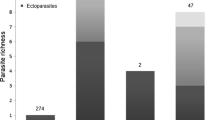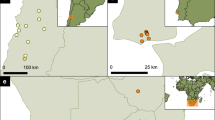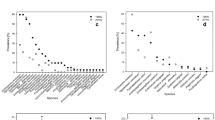Abstract
Release from parasites, pathogens or predators (i.e. enemies) is a widely cited ‘rule of thumb’ to explain the proliferation of nonindigenous species in their introduced regions (i.e. the ‘enemy release hypothesis’, or ERH). Indeed, profound effects of some parasites and predators on host populations are well documented. However, some support for the ERH comes from studies that find a reduction in the species richness of enemies in the introduced range, relative to the native range, of particular hosts. For example, data on helminth parasites of the European starling in both its native Eurasia and in North America support a reduction of parasites in the latter. However, North American ‘founder’ starlings were likely not chosen randomly from across Eurasia. This could result in an overestimation of enemy release since enemies affect their hosts on a population level. We control for the effects of subsampling colonists and find, contrary to previous reports, no evidence that introduced populations of starlings experienced a reduction in the species richness of helminth parasites after colonization of North America. These results highlight the importance of choosing appropriate contrast groups in biogeographical analyses of biological invasions to minimize the confounding effects of ‘propagule biases’.
Similar content being viewed by others
Abbreviations
- ERH:
-
–
- enemy release:
-
hypothesis
- NIS:
-
–
- nonindigenous:
-
species
References
AA Agrawal PM. Kotanen (2003) ArticleTitleHerbivores and the success of exotic plants: a phylogenetically controlled experiment Ecology Letters 6 712–715 Occurrence Handle10.1046/j.1461-0248.2003.00498.x
TM Blackburn RP. Duncan (2001) ArticleTitleEstablishment patterns of exotic birds are constrained by non-random patterns in introduction Journal of Biogeography 28 927–939 Occurrence Handle10.1046/j.1365-2699.2001.00597.x
CS Blaney PM. Kotanen (2002) ArticleTitlePersistence in the seed bank: the effects of fungi and invertebrates on seeds of native and exotic plants. Écoscience 9 509–517
B Blossey R Nötzold (1995) ArticleTitleEvolution of increased competitive ability in invasive nonindigenous plants: a hypothesis Journal of Ecology 83 887–889
EM. Boyd (1951) ArticleTitleA survey of parasitism of the starling Sturnus vulgaris L. in North America Journal of Parasitology 37 56–84 Occurrence Handle1:STN:280:Cy6D2Mvlslw%3D Occurrence Handle14825028
RM Callaway GC Thelen A Rodriguez WE. Holben (2004) ArticleTitleSoil biota and exotic plant invasion Nature 427 731–733
K Clay (1995) ArticleTitleCorrelates of pathogen species richness in the grass family Canadian Journal of Botany 73 S42–S49
RI Colautti HJ. MacIsaac (2004) ArticleTitleA neutral terminology to define ‘invasive’ species Diversity and Distributions 10 135–141 Occurrence Handle10.1111/j.1366-9516.2004.00061.x
RI Colautti A Ricciardi IA Grigorovich HJ. MacIsaac (2004) ArticleTitleIs invasion success explained by the enemy release hypothesis Ecology Letters 7 721–733 Occurrence Handle10.1111/j.1461-0248.2004.00616.x
CL Cooper JL Crites (1976) ArticleTitleAdditional checklist of helminths of starlings (Sturnus vulgaris L) American Midland Naturalist 95 191–194
MEA Cristescu PDN Hebert JDS Witt HJ MacIsaac IA. Grigorovich (2001) ArticleTitleAn invasion history for Cercopagis pengoi based on mitochondrial gene sequences Limnology and Oceanography 46 234–239
AP Dobson RM May (1986) Patterns of invasions by pathogens and parasites HA Mooney JA Drake (Eds) Ecology of Biological Invasions of North America and Hawaii Springer New York, NY 58–76
BJ Goodwin AJ McAllister L Fahrig (1999) ArticleTitlePredicting invasiveness of plant species based on biological information Conservation Biology 13 422–426 Occurrence Handle10.1046/j.1523-1739.1999.013002422.x
RD Gregory TM Blackburn (1991) ArticleTitleParasite prevalence and host sample size Parasitology Today 7 316–318 Occurrence Handle10.1016/0169-4758(91)90269-T Occurrence Handle1:STN:280:DC%2BD2cvpvVOlsQ%3D%3D Occurrence Handle15463402
JD Hair DJ Forrester (1970) ArticleTitleThe helminth parasites of the starling (Sturnus vulgaris L.): a checklist and analysis American Midland Naturalist 83 555–564
PJ Hudson A Rizzoli BT Grenfell H Heesterbeek AP. Dobson (2002) The Ecology of Wildlife Diseases Oxford University Press Oxford. 272
BL James LC Llewellyn (1967) ArticleTitleA quantitative analysis of helminth infestations in some passerine birds found dead on the Island of Skomer Journal of Helminthology 12 19–44
RM Keane MJ. Crawley (2002) ArticleTitleExotic plant invasions and the enemy release hypothesis Trends in Ecology and Evolution 17 164–170 Occurrence Handle10.1016/S0169-5347(02)02499-0
C Lever (1992) They Dined on Eland Quiller Press London. 224
JL Long (1981) Introduced Birds of the World Universe Books New York. 528
CE Mitchell AG. Power (2003) ArticleTitleRelease of invasive plants␣from fungal and viral pathogens Nature 421 625–627 Occurrence Handle10.1038/nature01317 Occurrence Handle1:CAS:528:DC%2BD3sXovFKnsQ%3D%3D Occurrence Handle12571594
RW Owen RT Pemberton (1962) ArticleTitleHelminth infection of the starling (Sturnus vulgaris L.) in northern England Proceedings of the Zoological Society of London 139 557–587
Permin A, Hansen JW (1998) Epidemiology, Diagnostics and Control of Poultry Parasites. Food and Agriculture Organization, United Nations, 160 pp
A Ricciardi HJ. MacIsaac (2000) ArticleTitleRecent mass invasion of the North American Great Lakes by Ponto-Caspian species Trends in Ecology and Evolution 15 62–65 Occurrence Handle10.1016/S0169-5347(99)01745-0 Occurrence Handle10652557
DJ Shaw BT Grenfell AP Dobson (1998) ArticleTitlePatterns of macroparasite aggregation in wildlife host populations Parasitology 117 597–610 Occurrence Handle10.1017/S0031182098003448 Occurrence Handle9881385
RR Sokal FJ. Rohlf (2001) Biometry EditionNumber3 WH Freeman New York. 887
SA Strauss AA Agrawal (1999) ArticleTitleThe ecology and evolution of plant tolerance to herbivory Trends in Ecology and Evolution 14 179–185 Occurrence Handle10322530
DR Strong DA Levin (1975) ArticleTitleSpecies richness of parasitic fungi of British trees Proceedings of the National Academy of Sciences USA 72 2116–2119
W Threlfall (1968) ArticleTitleHelminth parasites of some birds in Newfoundland Canadian Journal of Zoology 46 909–913 Occurrence Handle1:STN:280:CCaD2MbmsVA%3D Occurrence Handle5749650
J Tiainen T Pakkala (1997) Starling WJM Hagemeijer M Blair (Eds) The EBBC Atlas of European Breeding Birds: Their Distribution and Abundance Academic Press London, UK 688–689
ME Torchin CE. Mitchell (2004) ArticleTitleParasites, pathogens and invasions by plants and animals Frontiers in Ecology and the Environment 2 183–190
ME Torchin KD Lafferty AM. Kuris (2002) ArticleTitleParasites and marine invasions Parasitology 124 S137–S151 Occurrence Handle10.1017/S0031182002001506 Occurrence Handle12396221
ME Torchin KD Lafferty AP Dobson VJ McKenzie AM. Kuris (2003) ArticleTitleIntroduced species and their missing parasites Nature 421 628–630 Occurrence Handle1:CAS:528:DC%2BD3sXovFKntA%3D%3D Occurrence Handle12571595
Author information
Authors and Affiliations
Corresponding author
Rights and permissions
About this article
Cite this article
Colautti, R.I., Muirhead, J.R., Biswas, R.N. et al. Realized vs apparent reduction in enemies of the European starling. Biol Invasions 7, 723–732 (2005). https://doi.org/10.1007/s10530-004-0998-7
Received:
Accepted:
Issue Date:
DOI: https://doi.org/10.1007/s10530-004-0998-7




